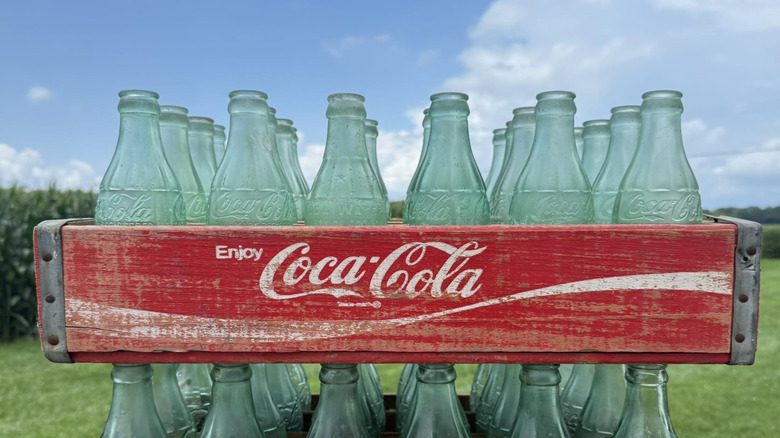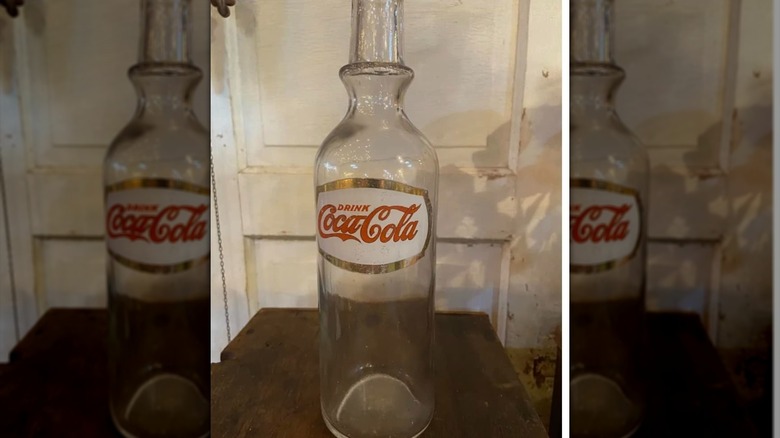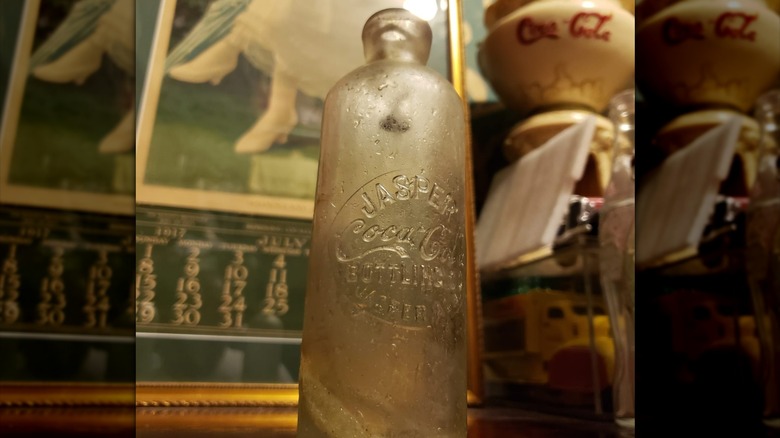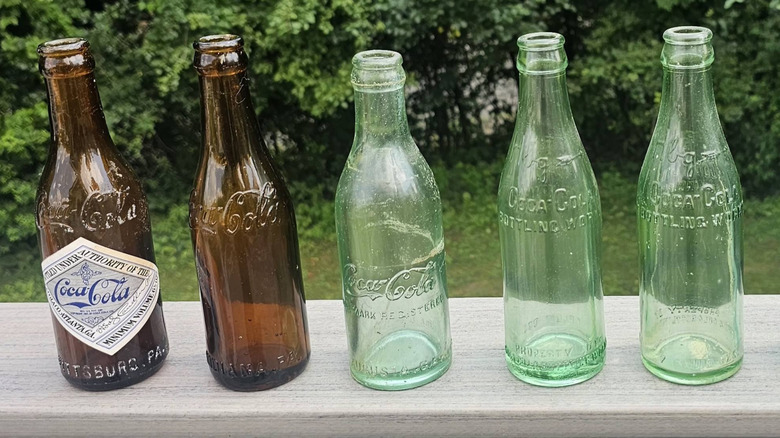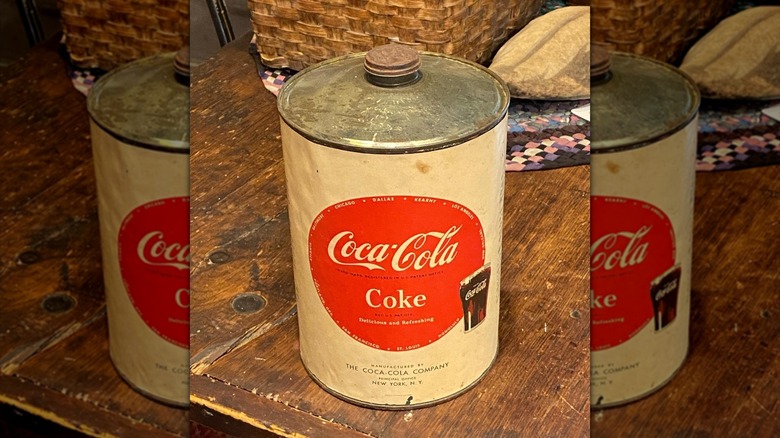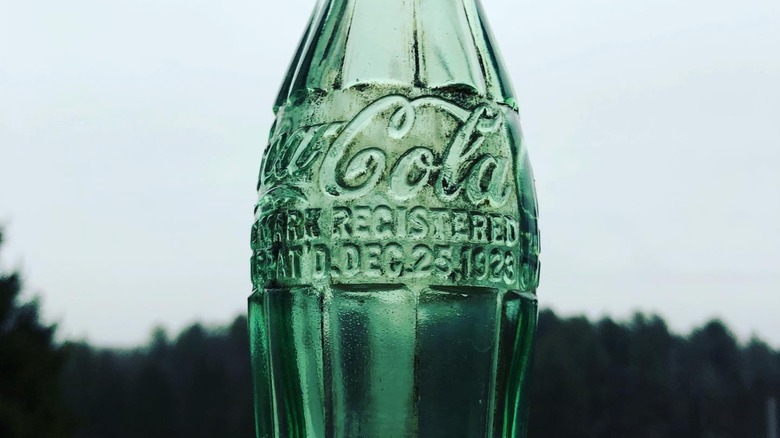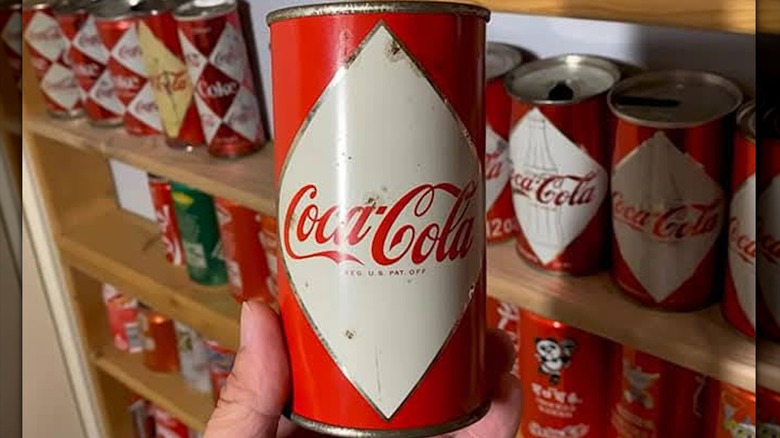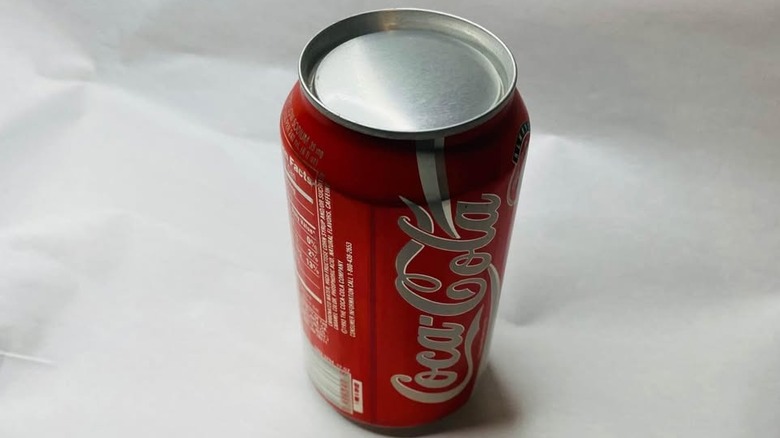Vintage Coke Bottles (And Cans) Worth More Money Than You Realized
One of the most recognizable American brands known the world over, Coca-Cola is a product so universally associated with its packaging that the shape of its bottle is a registered trademark. Despite Coke's minor misunderstanding with TIME magazine, its iconic bottle was even featured on TIME's 1950 cover, further evidence of this simple soft drink's long-standing cultural significance. Between avid fans and consumers (who've found the beverage useful for a variety of Coca-Cola hacks), Coke still remains a cultural staple, and its packaging is largely behind the brand's success. Designs for Coke bottles and cans have changed considerably over the years, leaving behind a variety of artifacts that have attracted collectors, many of whom are willing to pay high prices for rare pieces.
But even the oldest Coca-Cola bottles or cans are not necessarily the most valuable. Those regarded most highly by collectors depend on a series of factors, including where they were produced and what condition they're in. Those that were manufactured during a limited time frame or designed for specific events tend to be especially valuable. Even Coca-Cola products with manufacturing defects have become coveted collectibles for their inherent rarity. The fact that some Coke bottles and cans have sold for unbelievably high prices reveals just how much these objects are valued as historic artifacts. Here are ten examples of vintage Coke bottles and cans worth more money than you may have realized, proving how significant the brand's cultural impact remains.
Soda fountain syrup bottles
Before Coca-Cola bottles existed, the only way to enjoy the drink was to order it from the local soda fountain. Dr. John Stith Pemberton created it as a health tonic meant for various ailments, presenting this concentrated Coca-Cola syrup to Jacob's Pharmacy in Atlanta, Georgia, in 1886. Mixing it with carbonated water turned it into a sweet, bubbly, refreshing soft drink. Moderately popular as a beverage, it wasn't until 1899 that Coca-Cola began reaching clientele on a national scale, thanks to two lawyers' idea to bottle it so that it could be consumed anywhere.
Even as bottled Coke became available to consumers, soda fountains continued to be the predominant place to go for a glass of Coca-Cola made fresh, as the signature syrup mixed with carbonated water, and from the early 1900s and into the 1920s, this concentrate was typically kept in special glass bottles. As unique relics of early Coca-Cola history, these bottles are a rarer collectors' item that can be worth a considerable sum. Listings online suggest that a syrup bottle from around 1910, still complete with its metal measuring cap, could sell for about $300, with versions from 1920 valued closer to $200. Midcentury glass syrup jugs are also easily valued at around $400, and especially rare models have sold for much more. In 2012, a set of two Coca-Cola syrup bottles with rarer labels affixed between the layers of bottle glass sold for $2,200.
Hutchinson bottles
Because Coca-Cola bottles were typically manufactured in mass quantities, age doesn't always determine their value, as bottles from the turn of the century onwards are no strangers to antique stores, flea markets, and online purchasing sites. But the very first Coca-Cola bottles are worth quite a bit of money. Named Hutchinson Bottles for their metal seals, which predated the bottle cap, these were generic straight-sided glass bottles that were not exclusively used for Coca-Cola, but which became more distinct when the company embossed them with the Coca-Cola logo.
Hutchinson bottles' manufacturing dates fall between the 1890s and 1915. They're also marked with the manufacturing town, just as later designs continued to do. Being the very first Coca-Cola vessels produced during a limited time frame has made these bottles somewhat more difficult to find, so they're highly desirable as collectors' items. As for how much one of these Coca-Cola relics is actually worth, vendors estimate their value to fall between $1,000 and $8,500 online. Bottles marked with less common manufacturing towns tend to be worth more. Though a Coke bottle's condition is generally an important consideration in its pricing, Hutchinson bottles' rarity has ensured that even those in poor condition have a considerably elevated asking price, which falls around $900. Those in good condition can start at the asking price of $7,500, and could easily end up selling for much higher at an auction.
Straight-sided bottles
With the portable convenience of Hutchinson bottles, Coca-Cola as a beverage had reached every state by the year 1900. Facing continuous, growing demand, production facilities across the U.S. simply bottled the beverage in generic, straight-sided glass bottles. Before a patent was set in place in 1915, for a special contoured bottle which would mark the start of an evolution of Coca-Cola's signature packaging, these straight-sided bottles ranged somewhat in shape and size. They were also made with different colors of glass and marked with a variety of labels. Their value today depends on their color, condition, and manufacturing city. Irrespective of how much they're worth, collectors often seek these bottles, to build their own Coca-Cola chronology.
Lighter colored bottles from this era aren't always listed for high prices, but many collectors continue to seek them because the fact that they predate the brand's mass standardization makes them an important step in the chronology of Coca-Cola's bottling history. Some of these bottles are nevertheless considered to have some value. Online sellers list lighter straight-sided bottles up to $100. Those that are typically harder to find, and are correspondingly higher valued, are the amber-colored bottles from this era. These were manufactured specifically in the South and Midwest. Their online listing prices vary widely, falling anywhere from $250 to $800.
Soda fountain syrup cans
Though bulk Coca-Cola syrup at soda fountains was originally kept in glass bottles, this packaging eventually evolved, too. Starting around the 1930s, and remaining commonplace until the 1950s, Coca-Cola syrup was additionally packaged in one-gallon tin cans. These served the same purpose as the glass bottles which preceded them, as the general principle of Coca-Cola soda fountain mixology hadn't changed since the turn of the century — concentrated syrup was still mixed with carbonated water and then sold by the glass.
Relics from a time when soda fountains were still mainstream gathering places, and predating the later invention of single-serving Coca-Cola cans, these bulk metal cans are another less-common item among historic Coca-Cola relics. Sought after by collectors, they can easily be priced at a few hundred dollars. Cans in good condition — without much for rust or discoloration, and the original labelling still clear and intact — naturally come at a higher price. There seems to be a trend towards older syrup cans being worth more as well. Among the few available through online listings, Coca-Cola syrup cans from the 1950s are placed at about a $300 starting bid, whereas cans from the 1940s have a slightly higher asking price in the ballpark of $450. Being the most historic, syrup cans from the 1930s are listed even higher, just short of $600.
Rare hobbleskirt bottles
In the early days of bottled Coca-Cola, the brand ran into trouble with copycat colas imitating the product as well as the packaging. This was largely because the straight-sided glass bottles Coca-Cola came in were the same generic bottles used to bottle any other soft drink, and specialized labels proved to be easy enough to replicate. To deter copycats, the brand designed a uniquely shaped bottle. The winning idea was a contoured shape that flared out at the bottom. First patented in 1915, these were nicknamed "hobbleskirt" bottles, since the inspiration behind the original Coca-Cola bottle also echoed the silhouette of tapered skirts, which were à la mode at the time.
Since Coca-Cola hobbleskirt bottles were mass-produced on such an industrial scale, most of them aren't worth anything considerable. Supply and demand, however, means that collectors consider a select few of these 1915 bottles worth anything significant. Unusual colors tend to have a higher value — ice blue or light green hobbleskirt bottles are listed between $400 and $500 online. Those with printing errors are valued more highly for being unique, such as a 1952 bottle with a typo listed online for $450. But it's the rare prototype hobbleskirt bottles that have fetched astronomical prices online. Marked with the date one day before the patent was officiated, one of these sold for $245,000 at auction in 2011. In 2019, another such prototype was auctioned for over $108,000.
1923 Christmas Coke bottles
The patented hobbleskirt-shaped bottle featured across the country was the universally recognizable Coca-Cola shape by the 1920s, but patents were only valid for 14 years. In 1923, the hobbleskirt bottle patent needed to be renewed, and that year, the renewal date just so happened to fall on December 25th. This became the new date marked on the subsequent bottles at manufacturing plants across the country, which has led to these being nicknamed "Christmas bottles." Since their manufacture only took place until Coca-Cola's bottle patent required another renewal 14 years later, in 1937, these Christmas bottles existed under inherently limited production. As a result, they carry a whimsical but also significant remnant of Coca-Cola history, which has made them a desirable piece for many collectors.
Some reproductions of these bottles were produced in the 1980s, and inauthentic copies abound, though the original Christmas bottles from 1923 are still fairly distinguished by the smaller printing on the bottom of each bottle. True originals are another Coca-Cola relic considered to be quite valuable. Traditionally sized Christmas bottles in fair-but-imperfect condition are listed at around $75. There are also larger, 20" Christmas bottles, which are a rarer find, and subsequently come with a higher asking price, usually between $500 and $1,000.
Diamond cans
Coca-Cola cans were invented during wartime, a much later invention linked with necessary supply and demand during WWII. The first Coke cans were originally created for the U.S. Army as a convenient and far less breakable way to keep soldiers' thirst quenched, as they had not lost their taste for this nationally beloved American beverage during their time overseas. First introduced to the civilian populace in the 1960s, these flat-topped and flat-sided cans were red with a Coca-Cola logo printed inside a white diamond. Referred to subsequently as "diamond cans" among collectors, a few varieties with diamond patterns became the mainstream designs until Coca-Cola started experimenting with different shapes and graphics in later decades.
Even with a little bit of rust and discoloration, these diamond cans from the 1960s are among the more sought-after Coke cans among collectors, and if in decent condition, can easily be valued over $100, particularly if they were manufactured internationally. Original Canadian diamond Coca-Cola cans have been listed between $130 and $175. Japanese Coke cans, being less common, can be auctioned for much more, with starting bids of up to $400.
Factory defect Coca-Cola cans
Coca-Cola cans' value is, like the bottles, less contingent on age and more to do with rarity. While not necessarily the oldest Coke cans, those with manufacturing defects — many of which were never intended to leave the factory — often come listed at a higher price due to their being inherently more unique and unusual. These cans are highly sought after, granting them a higher value no matter what era they come from. Among the possibilities for defective cans, misprinting is a common mistake that, if not caught or addressed during the manufacturing process, can be a rare and coveted find. But among the defects that appeal to a lot of collectors are perfectly intact cans that have accidentally been sealed but not filled. Being hard to get hold of, these unopened, empty cans are desirable rarities. Sellers may ask for a price ranging from $250 to over $300.
Labelling mistakes are another factory defect that often merits a much higher asking price, as these can lead to rare, unique, and even one-of-a-kind cans. Collectors are often intrigued by typos, such as misspelled city names. One of the most expensive sales of a labelling defect was, however, a rare instance of a can with two labels, the Coca-Cola brand printed over with a Mountain Dew label. Whether this was intended as a rare trial can or a bona fide misprint, it was listed on eBay for $60,000.
Special event coke cans
Other Coca-Cola cans that have some value attached are those that were manufactured for special events. These unique Coke cans have occasionally been produced especially for significant sports events — from important tournaments to the Olympic Games. Due to their limited manufacturing, these cans were always intended to be special and thus automatically come with a rarity that many collectors value. However, similar to generic cans, many of these special event cans are also considered valuable if they have a manufacturing quirk. One such instance was a Final Four basketball Coke can listed for $250 on eBay, worthy of an elevated price for being unused and incomplete, as the can never made it through all the steps of production.
Coke cans manufactured for the Olympic Games are also collector's items, with older varieties typically worth more. Those with unusual manufacturing locations also have some value, with one can from the 1996 Olympics in Atlanta listed for almost $200 online, considered especially rare due to being unopened and manufactured in Bermuda. But as with the supply and demand that dictate the value of most Coca-Cola relics, those manufactured for more exclusive events are considered more valuable. One of the rarer special event runs for Coca-Cola cans was for the 1977 Jack Sellers Menlo College Scholarship Fund golf tournament. One of these cans sold for $1875 online, further supporting the value of limited-run Coca-Cola collectibles.
French Wine Coca bottles
French Wine Coca was an earlier concoction from the same Dr. Pemberton who created Coca-Cola, which was also intended to be consumed for health purposes. Introduced in 1885 as a tonic for headaches and nervousness, it was a mixture of wine and coca syrup, which came from the same plant used to make cocaine. Technically, Coca-Cola still makes cocaine, but this ingredient didn't enhance French Wine Coca's popularity back in the day. Because of national restrictions on alcohol, and being overshadowed by the more popular coca and French wine elixir known as Vin Mariani available overseas, French Wine Coca never became a mainstream beverage. Pemberton consequently focused his energy on developing an alcohol-free but equally stimulating version of his tonic. French Wine Coca served as a stepping stone to the more successful Coca-Cola syrup he mixed up a few years later, and any bottles that may still be out there are now among the rarest Coca-Cola relics. Only three are known to exist in the world.
The most recent French Wine Coca bottle to be made public was a fortuitous second-hand find back in 2014. Purchased for just $4 at a flea market, this bottle with its Pemberton label still reasonably intact, was quickly estimated to be worth much more. When left under the jurisdiction of Heritage Auctions, its starting bid was placed at $5,000. The bottle eventually sold for $13,750, showing just how valuable such a rare find was in the eyes of collectors.
